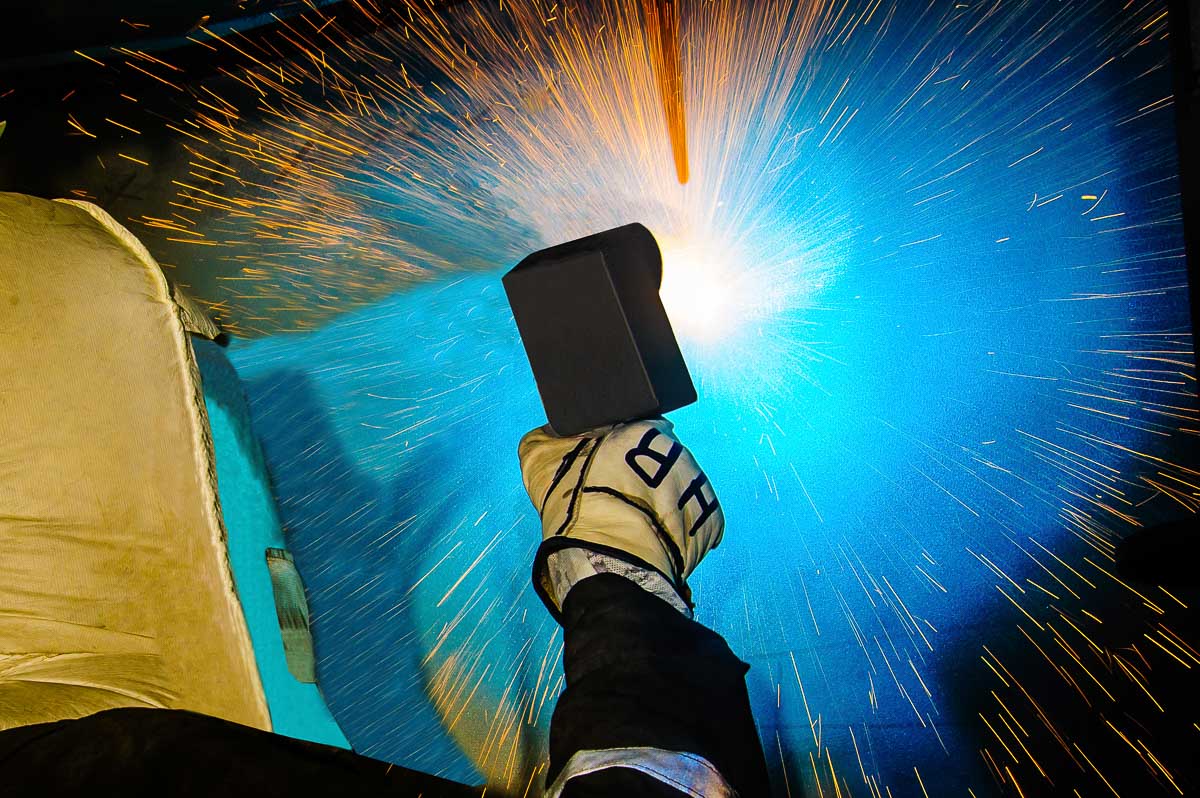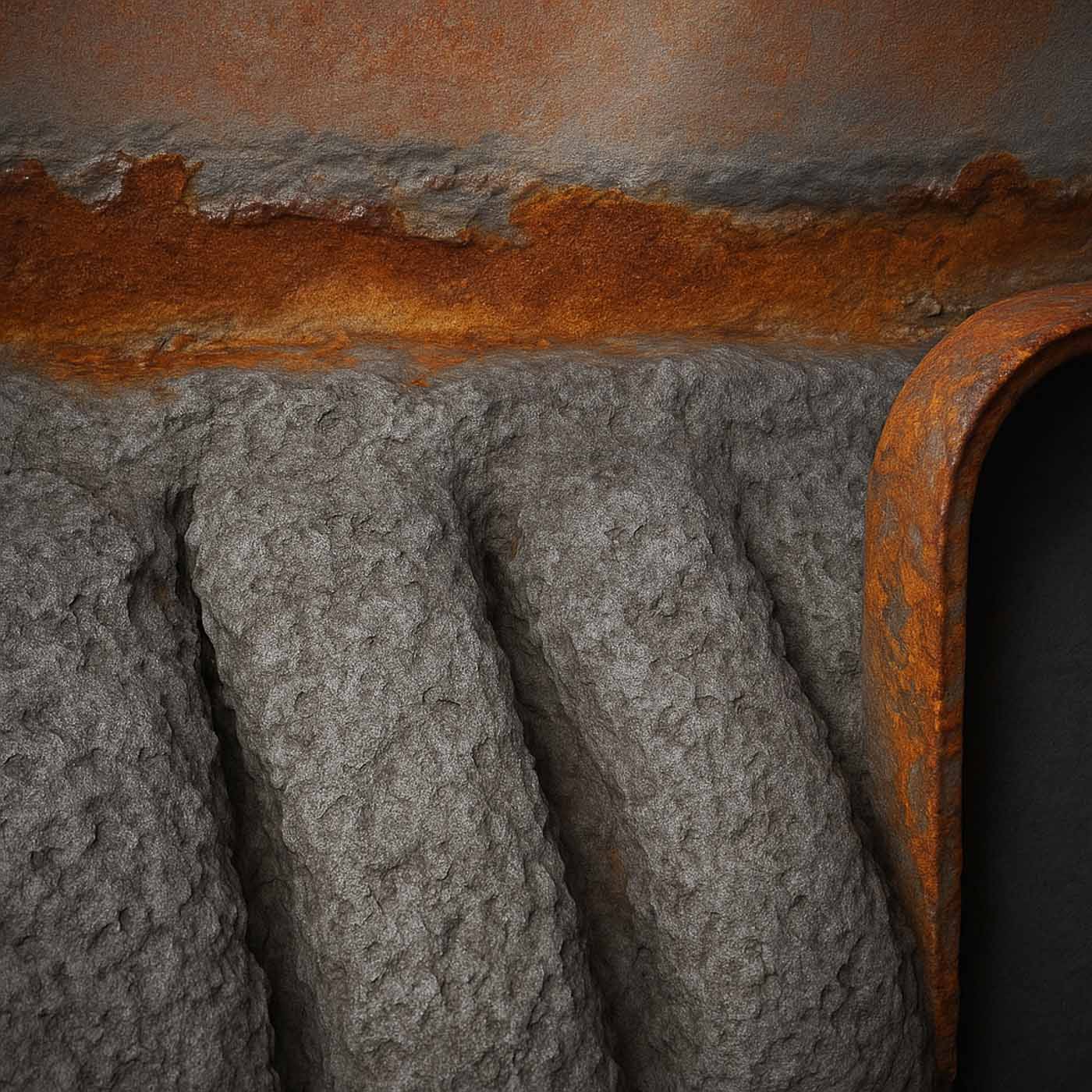Sulphuric Acid, Acid Gas Treatment and Sulfur Recovery Corrosion Protection for SRU, TGTU and Acid Gas Incinerators
Refinery sulphur management assets face persistent reliability theats from acid condensation and sulphur species. The most damaging mechanism in cool-end gas paths is sulphur dew point corrosion, where SO₂ and SO₃ combine with moisture to form sulphuric acid (H₂SO₄). Under these conditions, unprotected carbon steel and even high-alloy stainless steels can suffer rapid wastage, leaks and unplanned outages.
This page explains where sulphuric acid corrosion occurs across the sulphur recovery unit (SRU), tail gas treating unit (TGTU), acid gas treatment, and associated thermal or acid gas incinerators, how these processes work, why conventional coatings often underperform in this service, and how IGS MRP provides a robust, fast-installed upgrade that withstands H₂SO₄, HCl, H₂S and SO₂ exposure.
Where Sulphuric Acid Corrosion Appears in SRU, TGTU, Acid Gas Treatment and Incineration Systems
Sulphuric acid forms when flue or process gas containing SOx cools through the acid dew point. This is common in SRU waste heat boilers (WHBs), downstream transfer lines, quench and absorber sections in the TGTU, acid gas treating absorbers and regenerators, stack and ductwork, and in thermal or acid gas incinerator quench zones. During shutdowns, startups and turndowns, temperature cycling increases time spent in the dew point range, intensifying corrosion. Operators frequently observe sulphuric acid dew point corrosion at welds and crevices, where condensate concentrates and protective oxide films fail.
In parallel, H₂S, SO₂ and acidic water carryover can drive localised pitting and under-deposit corrosion, especially where halide ions such as chloride or bromide are present. These halides depress the acid dew point and increase the severity of attack. If unmitigated, the result is wall loss, leaks and premature equipment replacement that extends turnaround schedules.
How Acid Gas Treatment and Sulphur Recovery Units Work
Acid gas treatment units remove CO₂ and H₂S from process or natural gas streams using solvents such as amines. The acid gas, concentrated in H₂S, is then routed to the SRU. In the SRU, hydrogen sulphide is converted to elemental sulphur using a thermal reaction furnace followed by catalytic stages. In the thermal step, part of the H₂S is oxidised to SO₂, which then reacts with the remaining H₂S over catalysts to form sulphur. The process delivers very high furnace and WHB temperatures, followed by cooling, condensation and reheating across downstream equipment. These changing temperatures and gas compositions create alternating high-temperature sulphidation risks and low-temperature acid condensation risks in adjacent assets.
The TGTU further reduces residual SOx and H₂S to meet emissions limits. Solvent systems, quench sections and coolers concentrate acidic species and halides. Thermal and acid gas incinerators experience similar dew point cycling in quench and stack legs. Materials selection and surface protection must therefore address both corrosive chemistry and cycling temperature stresses.
Why Conventional Coatings and Alloys Fall Short
Traditional organic and inorganic coatings blister, permeate and degrade when exposed to hot acidic condensate, halide-laden deposits and steam-out conditions. Even corrosion-resistant alloys such as 316L, 904L, Alloy 20 or Incoloy 825 can suffer severe attack under wet H₂SO₄ condensate. Thermal spray or weld overlay materials, if not sealed or stress-relieved, contain porosity and stress pathways that allow corrosive media to penetrate. In dew point service this leads to under-film corrosion, disbondment and recurring repairs. Full alloy overlays also introduce significant cost, weld distortion and residual stress while still showing vulnerability to halide-laden condensate.

IGS MRP: Engineered Protection for Sulphuric Acid and Halide Environments
IGS MRP is a proprietary metal-reinforced polymer system that provides a defect-free protective surface with high mechanical strength. It is particularly resistant in low-pH service containing halide ions such as chloride and bromide, and it is engineered for dew point sulphuric acid corrosion. With a high Pitting Resistance Equivalent Number (PREN) and strong adhesion, the system delivers a robust barrier to H₂SO₄, HCl, H₂S, SO₂ and abrasive compounds, without the cost and complexity of full weld-overlay cladding.
Temperature capability extends to 180–190 °C (350–375 °F) in wet acid service, depending on process chemistry. Where process temperatures exceed this ceiling, IGS selects from its alloy cladding portfolio to ensure continuous protection across the operating profile.
Fast, In-Situ Installation That Protects Turnarounds
IGS installs MRP in situ, minimising the critical path and enabling a return to service in less than 12 hours from application. Resistance to steam-out and mechanical damage, plus straightforward refurbishment, shortens outage schedules and reduces repeat access requirements.
Proven Performance and Global Delivery
IGS has protected mission-critical process equipment against corrosion and wear for more than 20 years. Over 400,000 m² of surface protection have been applied across more than 3,000 projects in over 30 countries on 6 continents. In SRU, TGTU and acid gas treatment service, MRP has delivered continuous protection for more than a decade without recoating. The system has been tested in high halide concentrations, under submersed salt deposits and in ammonia service. It has consistently demonstrated reliable performance in H₂S, H₂SO₄ and SO₂ environments, with specific test data available on request.
Typical SRU, TGTU, acid gas treatment and incinerator applications for MRP
- SRU WHB outlets, downstream transfer lines and coolers
- TGTU quench sections and absorber inlets
- Acid gas treating absorbers and regenerator overheads
- Incinerator quench, stack and ductwork
- Condensate-prone sumps and knock-out pots
- Instrumentation stubs and nozzles where localised condensation occurs
Selecting the Right Protection for Your Sulphur Management Train
Every SRU, TGTU and acid gas treatment unit presents unique risks based on acid gas composition, halide loading, temperature cycles and water management. IGS engineers review operating data and inspection findings to define where MRP is optimal and where alloy cladding is required for higher-temperature sections. The outcome is a consistent barrier that mitigates corrosion across the sulphur management system.
Quality, Safety and Reliability
IGS delivers turnkey installations using fully trained and certified in-house teams operating under robust HSE and quality systems. Our safety-first culture is consistently recognised by customers as a differentiator, contributing to reliable execution and long-term performance.

Let’s Talk About Your Corrosion Challenge
If you are experiencing early wall loss, leaks or repeat repair scope caused by sulphuric acid dew point condensation in SRU, TGTU, acid gas treatment or incineration assets, request an IGS assessment. We can review operating data, advise on dew point control and halide risks, and specify an MRP or alloy-cladding solution that restores reliability while minimising turnaround impact.
Free consultation with an IGS Subject Matter Expert
IGS is here to provide information, answer questions and create an effective solution for your needs.
